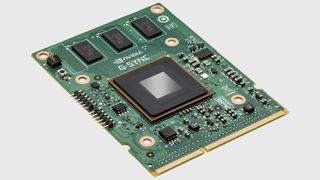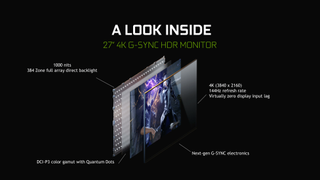Should I buy a G-Sync or FreeSync gaming monitor?
Everything you need to know about the two major monitor technologies.

Between resolution, panel types, and other monitor technologies, there's a lot to consider when buying a new gaming monitor. As we approach the Black Friday season, when tons of gaming monitors will be available at a discount, one of the biggest questions you'll have to address is: "Should I buy a G-Sync or FreeSync display?"
Before we look at answering that question, here’s a quick refresher on what these technologies are. Traditional displays that don’t natively support any form of adaptive sync have a fixed refresh rate, meaning they will display frames at a constant rate regardless of the framerate your games are running at. So if you are playing a game at 35 FPS and your monitor is refreshing at 60Hz, the monitor will regularly display two frames at once, resulting in what is called screen tearing.
You can get rid of screen tearing by turning on vsync in the game’s display options, but vsync can cause an even less desirable effect on your gaming experience, called stuttering. With vsync enabled, a game will stutter if your computer renders frames below the refresh rate of your display, often switching between 30fps and 60fps in a jarring manner.

G-Sync and FreeSync are solutions to both of these issues by having the display refresh at the same pace as frames are rendered by the graphics card, resulting in smooth, tear-free gaming.
Differences between G-Sync and FreeSync
Both G-Sync and FreeSync effectively do the same key thing: remove stutters and screen tearing in games. But because they are implemented differently, they each have benefits and downsides.
G-Sync monitors use a proprietary scaler provided by Nvidia and are limited to two inputs, DisplayPort and HDMI, and only DisplayPort supports adaptive sync. The scaler is a piece of hardware that manufacturers have to incorporate into their displays in order to support G-Sync, which increases their cost by an average of $200 (£150) compared to similar FreeSync options.

FreeSync is an open standard created by AMD and in order to work doesn't require any special hardware to be added to displays. In addition to being cheaper than G-Sync equivalents, FreeSync displays also offer more connectivity options including older inputs like DVI and VGA. On top of working over DisplayPort, FreeSync has the advantage of also working through HDMI, although from my own personal testing, FreeSync through HDMI doesn’t always work as expected.
The biggest gaming news, reviews and hardware deals
Keep up to date with the most important stories and the best deals, as picked by the PC Gamer team.
It’s important to understand that G-Sync only works with supported Nvidia graphics cards, and FreeSync only works with supported AMD cards. You won’t benefit from adaptive sync if you buy a FreeSync display and use it with an Nvidia graphics card, and vice versa.
Based on pricing alone you might think that FreeSync is always going to be a better option, provided you have an AMD card. However the G-Sync certification program ensures that all displays supporting it also have support for Low Framerate Compensation (LFC). LFC ensures that variable refresh rate will still work below the adaptive sync refresh window. In other words, a display that has an adaptive sync window of 40Hz to 100Hz will still suffer from screen tearing or stuttering if your framerate drops below 40fps. LFC will prevent this from happening and this is one of the key benefits that G-Sync offers over FreeSync, as most cheaper FreeSync displays don’t support LFC. AMD is aware of how important LFC is for the best adaptive sync experience so they have recently introduced a new adaptive sync technology called FreeSync 2. More on this later.

Which graphics cards support G-Sync and FreeSync?
G-Sync works on ‘Kepler’ GeForce 600 series or newer, and FreeSync works on ‘Sea Islands’ Radeon Rx 200 series or newer. You can use the displays normally with any other cards, but adaptive sync won’t work.
Is G-Sync or FreeSync really necessary?
Once you’ve used an adaptive sync display it’s hard to go back, but there are some cases where buying a display without adaptive sync might make sense, especially if you are on a tight budget. Gamers who play primarily competitive FPS games should prioritize a high refresh rate (120Hz and above) display—whether or not it has adaptive sync—over one that supports either FreeSync or G-Sync but has a refresh rate lower than 75Hz. However, in most other cases FreeSync and G-Sync will greatly improve your gaming experience.

The future: FreeSync 2 and G-Sync HDR
New displays have recently become available, with support for the new generation of adaptive sync—FreeSync 2 and G-Sync HDR. Despite the name, FreeSync 2 is not actually a successor to FreeSync, but rather both will coexist on the market. FreeSync 2 displays are guaranteed to have LFC, HDR support, and low latency—thanks to a validation program similar to G-Sync’s. Besides other features, the main selling point of both FreeSync 2 and G-Sync HDR is the support for adaptive sync in games that support HDR. As with any new first generation technology, however, these new displays, like the Acer X27 and Asus PG27UQ, are currently prohibitively expensive and therefore difficult to recommend, especially when HDR gaming content is scarce on the PC.
Most Popular

